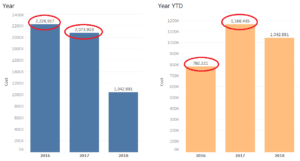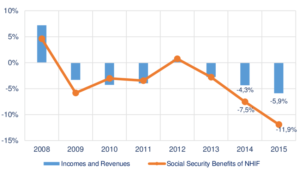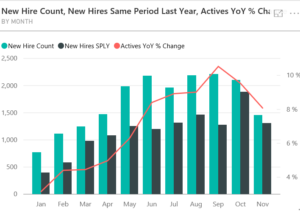What Is Year-Over-Year (YOY)?
Year-over year (YOY), sometimes called year-on-year, is a common monetary comparison that allows you to look at 2 or more measurable events annually. Perceptive YOY performance allows you to gauge if a company is improving, stagnant, or worsening in financial performance. You can see in financial reports how a particular company’s revenues increased for the third quarter. This is based on YOY data over the past 3 years.
KEY TAKEAWAYS
* Year-over year (YOY), may be a method of comparing the results of one measurement with those of a comparable amount annually.
* YOY Comparisons are an effective and popular way to evaluate the financial performance of an organisation.
Understanding YOY
YOY comparisons can be used to compare the financial performance of companies and investments. Any event that is repeated annually will be compared on an YOY basis. Common YOY comparisons include monthly, quarterly, or annual performance.
The Advantages of YOY
The YOY measurement allows for cross-referencing of different sets of data. A financial Analyst
The half-moon in 2021 was characterized by a 5% increase of internet revenues over the first quarter of the previous fiscal year. It is possible to make accurate comparisons by comparing constant months over many years. This is despite the seasonality of shopper behaviour.3 This YOY comparison can also be useful for investment portfolios. Investors like to compare YOY performance over time to see how performance has changed.
The Reasons Behind YOY
When analyzing a company’s performance, YOY comparisons can be very useful. They help to reduce seasonality which is a factor that could affect most businesses. Because most business lines have both a high and occasional demand season, sales, profits and other monetary metrics can change throughout the year.
Retailers have a peak season during the holiday searching season. This falls in the fourth quarter. It is sensible to compare revenue and profits YOY in order to accurately quantify a company’s performance.

It is important to compare the fourth quarter performance in one year with the fourth-quarter performances in other years. If a retailer makes a capitalist appearance in the fourth quarter, it could indicate that the organization is experiencing new growth. Similar to the previous quarter, a drastic decline might be seen in the fourth quarter compared with the first quarter. This could even be due to seasonality.
YOY conjointly is different from the term sequential. This refers to one quarter or one month and allows investors to see linear growth. The fourth quarter saw a decrease in the number of phones sold by technical schools compared to the third quarter, or the increase in the number of seats AN airline crammed into January compared to December.
Real World Example
Will Keith Kellog Company released mixed results for its fourth quarter 2018 data system report. It revealed that the company’s YOY earnings were still declining despite sales growth following acquisitions. Kellogg predicted that adjusted earnings would rise by 5% to 7 percent in 2019, as it maintained its position in alternative channels and packaging formats.

The company also announced plans to reorganize North America ANd Asia-Pacific sections. This included removing many divisions and reorganizing them into Will Keith Kellog Asia and the Middle East. Although earnings were down YOY, Kellogg’s strong presence and responsiveness towards shopper trends ensured that the overall outlook was positive.
What is YOY used for?
YOY can be used to make comparisons between one amount and another which was made one year ago. This allows for an annualized comparison such as third-quarter earnings this past year and the previous year. It is not common to compare a company’s profits or revenue growth. Additionally, it might not be used to describe annual changes in the economy’s cash supply, gross national product (GDP), or other economic measures.
How is YOY Calculated
YOY calculations can be done in simple terms and are usually expressed in share terms. This could involve taking the current year’s price, dividing it by previous year’s value, and subtracting one: (this years) / (last years) –
What is the Distinction between YOY and YTD?
At a 12-month change, YOY appears. Year up to now (YTD), measures the change relative to the beginning of the year (usually Jan.

What if I’m fascinated by comparisons for less than a year?
ready to figure month-over-month or quarter-over-quarter (Q/Q) in a lot of constant manner as YOY.|You can figure month-overmonth (Q/Q), in as many constant ways as YOY.} You can choose any time frame you like.
The Basics Of Finance And Accounting
No matter what your learning style is, understanding corporate finance or accounting can be made easy by choosing from 183,000 online video courses. Udemy will teach you accounting terminology, how to organize monetary statements, and how to analyze business transactions. Every course comes with a 30-day guarantee and new additions every month.














